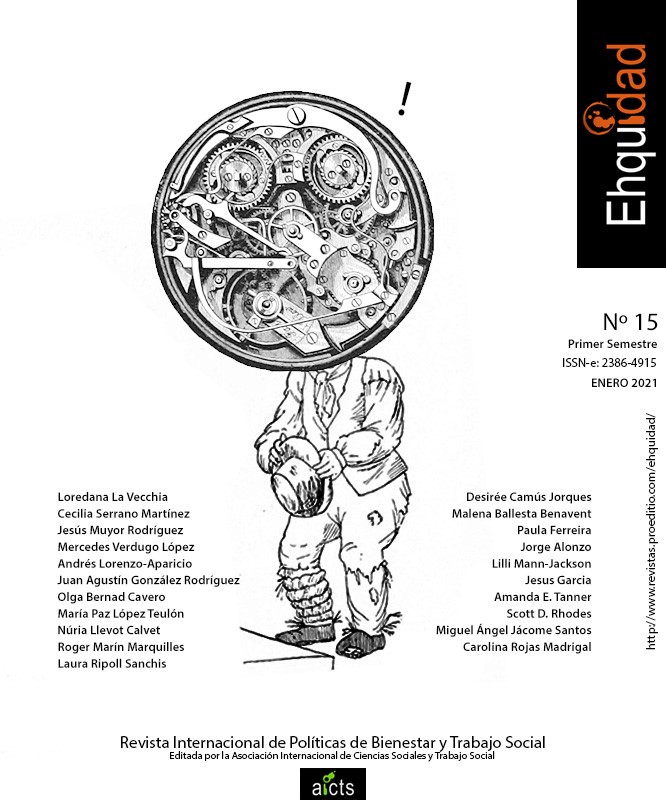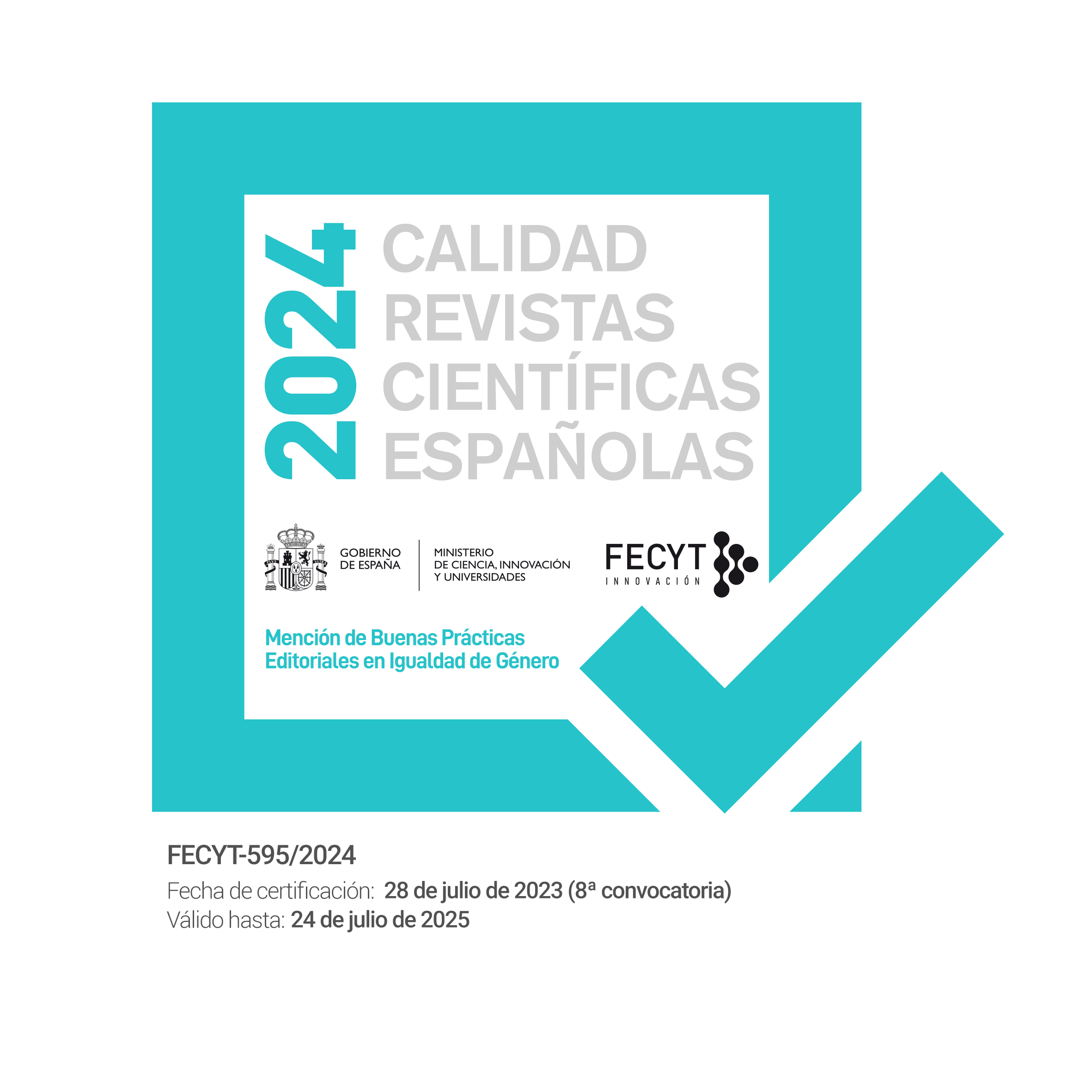Atendiendo las necesidades de jóvenes latinos gay, bisexuales y otros hombres que tienen sexo con hombres (HSH) y mujeres transgénero que viven con VIH a través de la intervención weCare en los Estados Unidos (EEUU)
DOI:
https://doi.org/10.15257/ehquidad.2021.0009Palabras clave:
Redes sociales, VIH, Inmigrantes, Supresión viral, Jóvenes HSH/mujeres transgéneroResumen
Objetivo: Los hombres gay, bisexuales y otros HSH (hombres que tienen sexo con hombres) y mujeres transgénero jóvenes en los EEUU que viven con VIH, particularmente aquellos que son latinos, tienen bajos índices de supresión viral. La intervención weCare utiliza las redes sociales para incrementar el compromiso de estos grupos poblacionales hacia su atención médica.
Método: Utilizamos el enfoque de investigación participativa basada en la comunidad para el desarrollo de la intervención y de mensajes teóricos, usando las redes sociales, considerando el contexto de cada participante. Analizamos los elementos y características de weCare, los mensajes enviados por el Educador de Salud Cibernético (ESC) y lecciones aprendidas para atender las necesidades de participantes latinos que viven con VIH.
Resultados: Identificamos 6 elementos esenciales, 5 características clave, mensajes efectivos usados y 8 lecciones importantes sobre las relaciones entre el ESC y las clínicas de VIH, el ESC y los participantes y los participantes y el sistema de salud.
Conclusiones: El uso de las redes sociales ofrece una plataforma prometedora para mantener la adherencia a los tratamientos médicos y lograr la supresión viral entre los jóvenes latinos gay, bisexuales y otros HSH y mujeres transgénero que viven con VIH.
Descargas
Citas
Bandura, A. (1986). Social Foundations of Thought and Action: A Social Cognitive Theory. Englewood Cliffs: Prentice-Hall.
Buchacz, K., Armon, C., Tedaldi, E., Palella, F. J., Novak, R. M., Ward, D., . . . Brooks, J. (2018). Disparities in HIV viral load suppression by race/ethnicity among men who have sex with men in the HIV Outpatient Study. AIDS Research and Human Retroviruses. doi: 10.1089/AID.2017.0162 [doi]
Centers for Disease Control and Prevention. (2019). HIV Surveillance Report, 2018 (Vol. 30). Atlanta, GA: Centers for Disease Control and Prevention.
Crepaz, N., Dong, X., Hess, K. L., & Bosh, K. (2020). Brief report: Racial and ethnic disparities in sustained viral suppression and transmission risk potential among persons aged 13-29 years living with diagnosed HIV infection, United States, 2016. Journal of Acquired Immune Deficiency Syndromes, 83(4), 334-339. doi: 10.1097/QAI.0000000000002277
Delbecq, A. L., Van De Ven, A. H., & Gustafson, D. H. (1986). Group Techniques for Program Planning: A Guide to Nominal and Delphi Processes: Green Briar Press.
Eng, E., Rhodes, S. D., & Parker, E. A. (2009). Natural helper models to enhance a community's health and competence. In R. J. DiClemente, R. A. Crosby & M. C. Kegler (Eds.), Emerging Theories in Health Promotion Practice and Research (Vol. 2, pp. 303-330). San Francisco, CA: Jossey-Bass.
Freire, P. (1970). Pedagogy of the Oppressed. New York, NY: Herder and Herder.
North Carolina HIV/STD Surveillance Unit. (2019). 2018 North Carolina HIV/STD Surveillance Report. Raleigh, North Carolina: North Carolina Department of Health and Human Services.
Pew Research Center. (2019). Social Media Fact Sheet. Washington, DC: Pew Research Center.
Relf, M. V., Pan, W., Edmonds, A., Ramirez, C., Amarasekara, S., & Adimora, A. A. (2019). Discrimination, medical distrust, stigma, depressive symptoms, antiretroviral medication adherence, engagement in care, and quality of life among women living with HIV in North Carolina: A mediated structural equation model. Journal of Acquired Immune Deficiency Syndromes, 81(3), 328-335. doi: 10.1097/QAI.0000000000002033
Rhodes, S. D., Alonzo, J., Mann, L., Freeman, A., Sun, C. J., Garcia, M., & Painter, T. M. (2015). Enhancement of a locally developed HIV prevention intervention for Hispanic/Latino MSM: A partnership of community-based organizations, a university, and the Centers for Disease Control and Prevention AIDS Education and Prevention, 27(4), 312-332.
Rosen, J. G., Malik, M., Cooney, E. E., Wirtz, A. L., Yamanis, T., Lujan, M., . . . Poteat, T. (2019). Antiretroviral treatment interruptions among Black and Latina transgender women living with HIV: Characterizing co-occurring, multilevel factors using the gender affirmation framework. AIDS and Behavior, 23(9), 2588-2599. doi: 10.1007/s10461-019-02581-x
Sun, C. J., Stowers, J., Miller, C., Bachmann, L. H., & Rhodes, S. D. (2015). Acceptability and feasibility of using established geosocial and sexual networking mobile applications to promote HIV and STD testing among men who have sex with men. AIDS and Behavior, 19(3), 543-552.
Sweeney, S. M., & Vanable, P. A. (2016). The association of HIV-related stigma to HIV medication adherence: A systematic review and synthesis of the literature. AIDS Behav, 20(1), 29-50. doi: 10.1007/s10461-015-1164-1
Tanner, A. E., Philbin, M. M., & Ma, G. (2014). HIV prevention interventions with adolescents: Innovations and challenges in partnerships across the integrated transitions model. In S. D. Rhodes (Ed.), Innovations in HIV Prevention Research and Practice through Community Engagement (pp. 77-104). New York, NY: Springer.
Wallerstein, N. (1994). Empowerment education applied to youth. In A. C. Matiella (Ed.), The Multicultural Challenge in Health Education (pp. 153-176). Santa Cruz, CA: ETR Associates.













